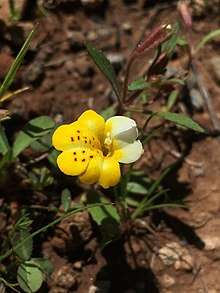Erythranthe bicolor
Erythranthe bicolor, the yellow and white monkeyflower,[1][2] is a species of flowering plant in the lopseed family (Phrymaceae). It is endemic to California, United States. It was formerly known as Mimulus bicolor.[3][4][5][6]
| Erythranthe bicolor | |
|---|---|
 | |
| Scientific classification | |
| Kingdom: | Plantae |
| Clade: | Tracheophytes |
| Clade: | Angiosperms |
| Clade: | Eudicots |
| Clade: | Asterids |
| Order: | Lamiales |
| Family: | Phrymaceae |
| Genus: | Erythranthe |
| Species: | E. bicolor |
| Binomial name | |
| Erythranthe bicolor | |
Description
It is an annual herb producing a hairy, erect stem 4 to 27 centimeters tall. The linear to nearly oval leaves are each up to 3 centimeters long and arranged in opposite pairs about the stem. The tubular base of the flower is surrounded by a reddish-green freckled calyx of sepals with small, pointed lobes. The flower corolla is one to two centimeters long and divided into two lips. These vary in color but often the upper lip is white and the lower is yellow. The upper lip has two lobes and the lower has three. Each lobe has two sub-lobes at its tip.
Distribution and habitat
The yellow and white monkeyflower grows in mountains and foothills from the Klamath Range through the Sierra to the Tehachapi Mountains. It grows in moist or wet areas, often on clay soils.[7]
References
- "Mimulus bicolor". Natural Resources Conservation Service PLANTS Database. USDA. Retrieved 2018-10-30.
- "Erythranthe bicolor". Calflora: Information on California plants for education, research and conservation, with data contributed by public and private institutions and individuals, including the Consortium of California Herbaria. Berkeley, California: The Calflora Database – via www.calflora.org.
- Barker, W.R.; Nesom, G.L.; Beardsley, P.M.; Fraga, N.S. (2012), "A taxonomic conspectus of Phrymaceae: A narrowed circumscriptions for Mimulus, new and resurrected genera, and new names and combinations" (PDF), Phytoneuron, 2012-39: 1–60CS1 maint: uses authors parameter (link)
- Beardsley, P. M.; Yen, Alan; Olmstead, R. G. (2003). "AFLP Phylogeny of Mimulus Section Erythranthe and the Evolution of Hummingbird Pollination". Evolution. 57 (6): 1397–1410. doi:10.1554/02-086. JSTOR 3448862.
- Beardsley, P. M.; Olmstead, R. G. (2002). "Redefining Phrymaceae: the placement of Mimulus, tribe Mimuleae, and Phryma". American Journal of Botany. 89 (7): 1093–1102. doi:10.3732/ajb.89.7.1093. JSTOR 4122195. PMID 21665709.
- Beardsley, P. M.; Schoenig, Steve E.; Whittall, Justen B.; Olmstead, Richard G. (2004). "Patterns of Evolution in Western North American Mimulus (Phrymaceae)". American Journal of Botany. 91 (3): 474–4890. doi:10.3732/ajb.91.3.474. JSTOR 4123743. PMID 21653403.
- Jepson Manual Treatment